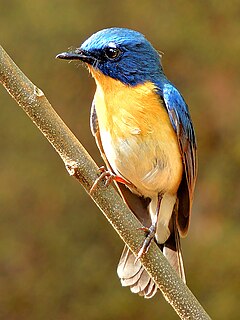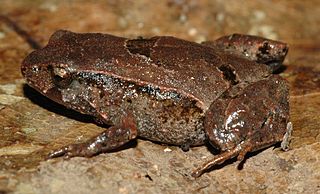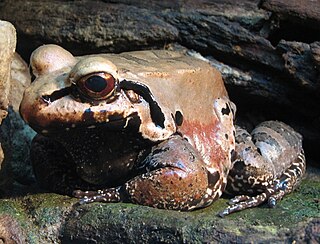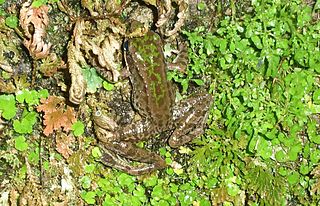
Tickell's blue flycatcher is a small passerine bird in the flycatcher family. This is an insectivorous species which breeds in tropical Asia, from the Indian Subcontinent eastwards to Bangladesh and western Myanmar. The Indochinese blue flycatcher was formerly considered conspecific. They are blue on the upperparts and the throat and breast are rufous. They are found in dense scrub to forest habitats.

The grey-headed canary-flycatcher, sometimes known as the grey-headed flycatcher, is a species of small flycatcher-like bird found in tropical Asia. It has a square crest, a grey hood and yellow underparts. They are found mainly in forested habitats where they often join other birds in mixed-species foraging flocks. Pairs are often seen as they forage for insects by making flycatcher-like sallies and calling aloud. Several subspecies are recognized within their wide distribution range. In the past the genus Culicicapa was considered to be an Old World flycatcher but studies have found them to belong to a new family designated as the Stenostiridae or fairy flycatchers that include the African genera Stenostira and Elminia.

The pouched frog, or hip pocket frog, is a small, terrestrial frog found in rainforests in mountain areas of south-eastern Queensland and northern New South Wales, Australia. It is the sole species within the genus Assa, and is part of the family Myobatrachidae.

Nannophrys is a genus of frogs endemic to Sri Lanka. It used to be placed in the large frog family Ranidae but a phylogenetic study was undertaken using DNA sequences and it is now included in the family Dicroglossidae. They are sometimes known under the common name streamlined frogs.

Indosylvirana aurantiaca, commonly known as the golden frog, is a species of frog endemic to the Western Ghats of India. The species is also known as the Trivandrum frog, the common wood frog, or the small wood frog.

Atelopus glyphus, the Pirri harlequin frog or Pirri Range stubfoot toad, is a species of toad in the family Bufonidae found in Colombia and Panama within the Northwestern Andean montane forests. Its natural habitats are subtropical or tropical moist montane forests and rivers.

Aplastodiscus albosignatus, also known as the Bocaina treefrog, is a species of frog in the family Hylidae. It is endemic to Brazil. Its natural habitats are subtropical or tropical moist lowland forests, subtropical or tropical moist montane forests, and rivers. It is threatened by habitat loss.

Aplastodiscus leucopygius is a species of frog in the family Hylidae, endemic to Brazil. Its natural habitats are subtropical or tropical moist lowland forests, rivers, intermittent freshwater marshes, plantations, rural gardens, heavily degraded former forests, and irrigated land.

The Sierra Juarez brook frog is a species of frog in the family Hylidae endemic to Mexico. Its natural habitats are subtropical or tropical moist lowland forests, subtropical or tropical moist montane forests, and rivers. It is threatened by habitat loss and possibly by chytridiomycosis, and the IUCN has assessed its conservation status as near threatened.

The New England tree frog or glandular tree frog is a species of frog in the family Pelodryadidae, endemic to Australia. Its natural habitats are temperate forests, subtropical or tropical moist lowland forests, subtropical or tropical moist montane forests, temperate shrubland, rivers, and pastureland. It is threatened by habitat loss.
The locust coqui is a species of frog in the family Eleutherodactylidae endemic to Puerto Rico. Its natural habitats are subtropical or tropical moist lowland forests and subtropical or tropical moist montane forests. E. locustus has suffered a population decline of more than 80% due to introduced predators and amphibian chytrid disease. Scientists believe amphibian chytrid disease may be exacerbated by climate change - warmer temperatures in dry, moist habitats, causing stress that may lead to greater susceptibility to the disease.

The smoky jungle frog is a species of frog in the family Leptodactylidae. It is found in Bolivia, Brazil, Colombia, Ecuador, Costa Rica, Panama, French Guiana, and Peru. Its natural habitats are tropical and subtropical moist broadleaf forests, subtropical or tropical swamps, subtropical or tropical moist montane forest, rivers, freshwater marshes, intermittent freshwater marshes, and aquaculture ponds.

Lithodytes is a genus of frogs in the family Leptodactylidae. It is monotypic, being represented by the single species, Lithodytes lineatus, the gold-striped frog or painted antnest frog. It is found in tropical South America where it lives in humid forests among the leaf litter. These frogs build foam nests at the edge of temporary pools, and the tadpoles develop within these. The frogs also associate with certain leafcutter ants and breed inside their nests without being attacked by the ants.

The Natal dwarf puddle frog is a species of frog in the family Phrynobatrachidae. It is found in Angola, Benin, Botswana, Burundi, Cameroon, Central African Republic, Republic of the Congo, Democratic Republic of the Congo, Ivory Coast, Eritrea, Ethiopia, Gambia, Ghana, Guinea, Guinea-Bissau, Kenya, Liberia, Malawi, Mali, Mozambique, Namibia, Nigeria, Rwanda, Senegal, Sierra Leone, South Africa, Sudan, Swaziland, Tanzania, Togo, Uganda, Zambia, Zimbabwe, and possibly Burkina Faso, Chad, Lesotho, and Mauritania.

Nannophrys marmorata, commonly known as Kirtisinghe's rock frog or marbled streamlined frog, is a species of frog endemic to Sri Lanka. It used to be placed in the large frog family Ranidae but a phylogenetic study was undertaken using DNA sequences and it is now included in the family Dicroglossidae. Its natural habitats are tropical moist lowland forests, moist montane forests, rivers and streams. It is threatened by habitat loss.

Odorrana swinhoana is a species of frog in the family Ranidae. It is endemic to Taiwan and widely distributed in hilly areas below 2,000 m (6,600 ft). It is named for Robert Swinhoe, a British naturalist and diplomat. Its common names include Swinhoe's brown frog, Bangkimtsing frog, brown-backed odorous frog, Taiwan odorous frog, and Taiwan sucker frog.
Taruga fastigo is a species of frogs in the family Rhacophoridae. It is endemic to Sri Lanka and only known from its type locality, Morningside Estate near Rakwana. Prior to its description in 2001, it was confused with Polypedates eques.

The Rose's ghost frog or Table Mountain ghost frog is a species of frog in the family Heleophrynidae endemic to South Africa. It is a medium-sized species with purple or brown blotches on a pale green background and large discs on its fingers and toes. It has a very restricted range, being only known from the slopes of parts of Table Mountain. The tadpoles live in permanent streams but these are in danger of drying up because of the establishment of pine plantations. Because of its small range and changes in its habitat, this frog is listed as critically endangered by the International Union for Conservation of Nature.

The black-backed forktail, occasionally referred to as the black-throated forktail, is a forktail species in the family Muscicapidae. The species was described in 1836, from a specimen collected in Nepal. It is a medium-sized forktail, weighing between 25 and 29 grams, with a length of 20.5 to 23 centimetres. The species has a broad white stripe across its forehead. The crown, face, and mantle are black, while the bird's underparts are white, sharply divided from the black above. The wings are largely black with a broad white stripe across the greater coverts. The tail of the species, similar to that of other forktails, is long, graduated, and deeply forked. The tail is black with a white tip and three white bands created by shorter tail feathers. The beak of the bird is black, while the feet and legs are light pink, and the iris is brown. The species is monomorphic.




















